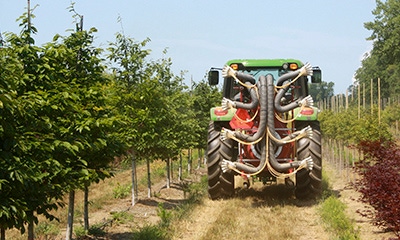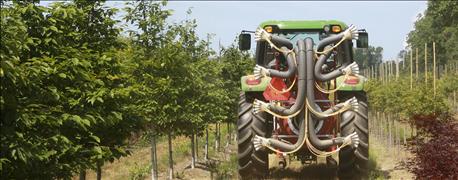February 2, 2016

Fruit industry researchers have been working on developing “smart” spraying systems for years. That work is finally bearing fruit – the sort that goes into the bank account, not just the packing shed.
What’s more, it’s likely to warrant equipment changes by producers hesitant to replace or upgrade older sprayers. Reason: Where today’s spray material are placed is often more important than how much is delivered – particularly high-density plantings.

AUTOMATED, REAL-TIME SPRAY CONTROL: New, automated spraying systems can detect the presence, size, shape and foliage density of trees and apply optimum pesticide amounts on the go.
Sensor-based intelligent decision systems are at least close to being field-ready for different sprayer types, thanks to a USDA Ag Research Service team for different sprayer types. In brief, laser-guided spraying system controls spray outputs to match targeted tree structures – with greater precision and less waste.
“Conventional spray application technology requires excessive amounts of pesticide to achieve effective pest control in floral, nursery, orchard and other specialty crops,” explains Heping Zhu, ARS ag engineer at Ohio State University’s Wooster research center. “This challenge is now overcome by an automated, variable-rate, air-assisted, precision sprayer. The new system is able to characterize the presence, size, shape and foliage density of target trees and apply the optimum amount of pesticide in real time.”
The research team includes other colleagues at Ohio State, Oregon State University and University of Tennessee. The team conducted field trials to assess the technology’s performance in six commercial nurseries in all three states.
How precision intelligence sprayers pay
The system has many parts that have to work together, notes Zhu. It integrates a high-speed laser-scanning sensor with a Doppler radar travel-speed sensor, an automatic nozzle-flow-rate controller, an embedded computer, a touch screen, a manual switch box plus four five-port nozzle manifolds on each side of an air-assist sprayer. The sprayer can treat two rows of trees at a time.
Compared to conventional sprayers with best pest management practices, the precision system consistently sprayed the correct amount of chemicals, despite changes in tree structure and species. It also deposited the spray more uniformly on the targets, even at different growth stages.
“Pest control with the new sprayer was comparable to that of conventional sprayers,” says Zhu. “But the new sprayer reduced average pesticide use between 46% and 68%, with an average pesticide cost savings of $230 per acre for ornamental nurseries.
Cost savings can be much higher for orchards and other fruit crop productions. An apple orchard test, for example, demonstrated that the new sprayer reduced spray loss beyond tree canopies between 40% and 87%, airborne spray drift by up to 87%, and spray loss on the ground between 68% and 93%.
“This new precision spraying system significantly advances the technology for efficient variable-rate pesticide applications.” And Zhu concludes, “It offers an environmentally responsible approach to controlling insects and diseases.”
Article provided by Sharon Durham, ARS information staff.
You May Also Like




